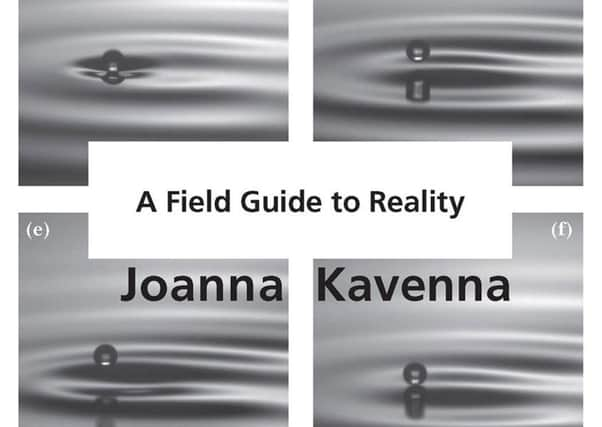Book review: A Field Guide To Reality by Joanna Kavenna


A Field Guide To Reality by Joanna Kavenna, riverrun, £14.99
Joanna Kavenna – whom it was my pleasure to select as one of the Granta Best of Young British Novelists in 2013 – is the kind of writer who must drive publicists and booksellers to the rending of raiments. Her first book, The Ice Museum of 2005, was ahead of the game in being the kind of genre-mashing non-fiction that now regularly features in the bestsellers lists; and it was rewarded with appearances on numerous prize shortlists. She then turned to fiction, publishing Inglorious in 2007; The Birth Of Love in 2010 and Come To The Edge in 2012.
Advertisement
Hide AdThe problem – for the industry, not the reader – is how different they are as books. Inglorious, about Rose Lane’s philosophical and emotional mid-life crisis, reminded me of Thomas Bernhard in its intelligence, its ruthlessness and its self-sabotaging wit. The Birth Of Love was a triptych about childbirth, part historical novel, part unflinching realism, part science fiction. Come To The Edge was a laugh-out-loud comedy about conservative rural anarchism – second homes in the Lake District were sequestered by the priced-out and put-upon locals – that had serious political import at the same time. Now we have A Field Guide To Reality, a book again in a different genre and with different concerns.
Eliade Jencks, a waitress working in Oxford, is awoken late at night by a phone call to tell her that one of her few friends, Professor Solete, has died. He has left a box which his academic peers very much hope contains the manuscript of the treatise he had been working on for decades, the Field Guide To Reality. But the box is emblazoned with strict instructions that only Eliade is to open it, and in it she finds a quest that will cross her path with a sculptor of pine-cones, a barge-dweller obsessed with the murdered philosopher Hypatia, a museum of discredited theories, a chrysanthemum cult, quantum physicists and ancient circular barrows that can be zeroes and haloes at the same time. Time bleeds in this novel, with the supposed first Chancellor of Oxford, Robert Grosseteste, the Arabic writer Alhazen, William of Ockham, John Locke, Mary Somerville and others flitting in and out of the narrative like dust motes caught in light.
It brought to mind several novelists who have similarly explored big ideas in fleet fictions: Scarlett Thomas and Andrew Crumey most particularly. But Kavenna’s alternate Oxford, with its Nightingale College and Swinbrook Lane, also chimes with those other chroniclers of Oxford’s otherness; Philip Pullman and Lewis Carroll, both similarly concerned with how the novel can be a vehicle to discuss the mathematical, the theological and the mad. Citing such parallels runs the risk of making Kavenna’s novel appear less original than it is. The book’s restlessness in terms of genre – one minute campus comedy, the next elegiac wistfulness, bemused one minute and enthrallingly enlightened the next – perfectly mirrors the novel’s major theme. Are theories about reality “real”, or just provisional, working methods that allow us to navigate the world, which is, as Louis MacNeice wrote, “suddener than we fancy it”?
There is a viewpoint that English-language fiction is peculiarly resistant to the “novel of ideas”. They get Tolstoy, we get Trollope. It’s a false dichotomy, but I think that the “novel of ideas” here has tended to work best by wit, by wryness and by irony more than by speechifications. Although this novel deals with the nature of light and enlightenment, quantum physics and strange attractors, grieving and gifting, it is bristling with acute little observations. One character, in “Tweed jacket, mustard scarf, burgundy cords. Such a clash of shades and tones, as if he was daring you to protest” is someone of which she thinks “you couldn’t get much more don than that”. Having delivered an essay to a tutor in almost exactly that sartorial eye-shock, I winced at remembering. I winced doubly in that I would probably wear it now.
There is a very English kind of surrealism at play in this novel. “The fool thinks he is wise, the wise man knows he is a fool”, one character says, “Then you have the wise man who knows he is a fool, and therefore occasionally gets confused and consorts with genuine fools who are infinitely more foolish than he is – because of course he is not a fool but a wise man after all”. “I really didn’t know how to respond,” the heroine admits. “It’s a category error,” she is rebuked.
For all the cerebral shenanigans, the novel has a core of loneliness, where ideas can be more present to us than the living or the dead, where “what if” and “if only” are more tangible than the here and now. The fact that Kavenna’s Oxford is perpetually swathed in mist, a place of glimpses and intellectual will-o’-the-wisps is no surprise. Her reality is often rude customers and damp clothes; her unreality is expansive and profound.
Advertisement
Hide AdPhilip Dick, a man who was always publicised in the same way, once wrote that “reality is that which, when you stop believing in it, doesn’t go away”. This novel of Roger Bacon and baked beans, a comic metaphysical thriller, is a nebulous and sharp delight. What does unite Kavenna’s work? Nothing yet, I hope.